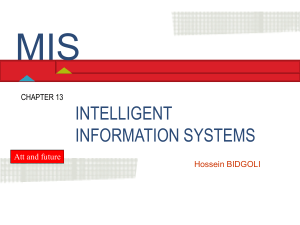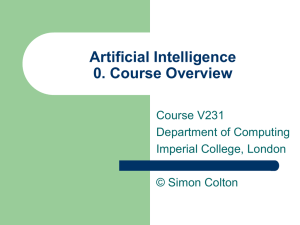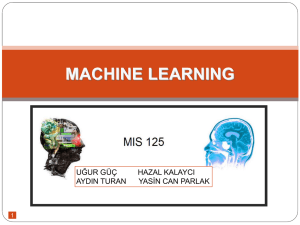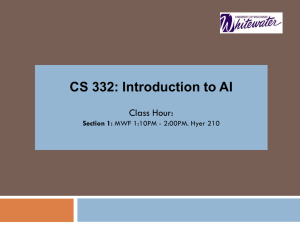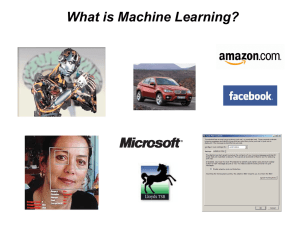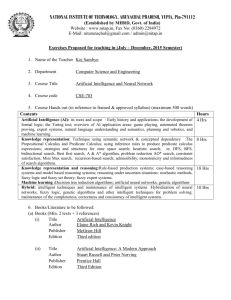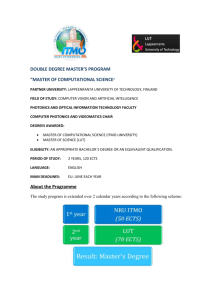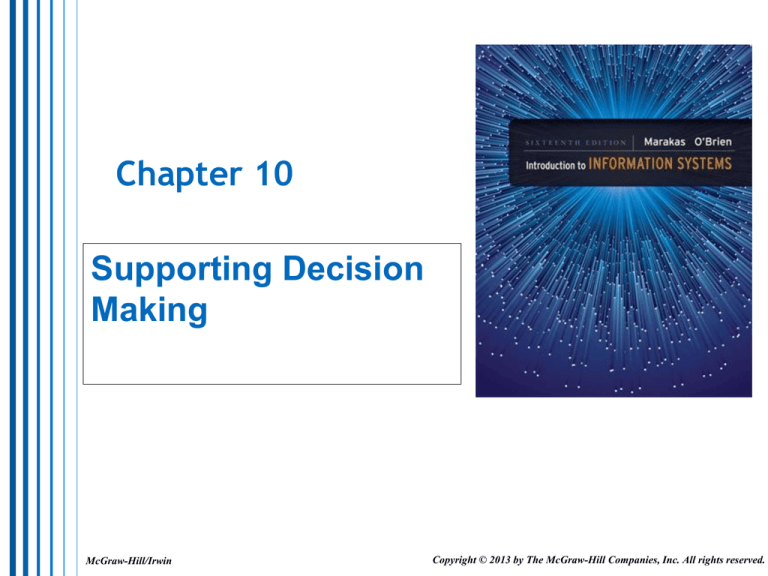
Chapter 10
Supporting Decision
Making
McGraw-Hill/Irwin
Copyright © 2013 by The McGraw-Hill Companies, Inc. All rights reserved.
Learning Objectives
Identify the changes taking place in the form
and use of decision support in business.
Identify the role and reporting alternatives of
management information systems.
Describe how online analytical processing can
meet key information needs of managers.
Explain the decision support system concept
and how it differs from traditional
management information systems.
10-2
Learning Objectives
Explain how the following information systems
can support the information needs of
executives, managers, and business
professionals:
Executive information systems
Enterprise information portals
Knowledge management systems
10-3
Learning Objectives
Identify how neural networks, fuzzy logic,
genetic algorithms, virtual reality, and
intelligent agents can be used in business.
Give examples of several ways expert systems
can be used in business decision-making
situations.
10-4
Section 1
Supporting Decision Making
10-5
I. Introduction
An organization is a nexus of decisions with
information needs supplied by an Information System
Information, Decisions, and Management – the type of
information required by decision makers is directly
related to the level of management decision making
and the amount of structure in the decision situation
Strategic Management – executive level, long-range plans,
organizational goals and policies, and objectives
Tactical Management – mid-level management, medium- and
short-range plans to support objectives made by executives,
and allocation of resources and performance monitoring of
organizational subunits
Operational Management – short-range plans, day-to-day
operations, direct the use of resources and performance of
tasks
10-6
I. Introduction
Information Quality – characteristics of information
products
Timeliness – was information present when needed?
Accuracy – was the information correct & error free?
Completeness – was all the needed information there?
Relevance – was the information related to the situation?
Decision Structure
Structured – operational level, occur frequently, much
information available
Semistructured – managerial level (most business decisions
are here), not as frequent, less information available
Unstructured – executive level, infrequent, little information
available
10-7
I. Introduction
Information Requirements of Decision Makers
10-8
I. Introduction
Dimensions
of
Information
10-9
II. Decision Support Trends
Using IS to support business decision
making is increasing
Business Intelligence (BI) – improving
business decision making using factbased support systems
Business Analytics (BA) – iterative
exploration of a firm’s historical
performance to improve the strategic
planning process
10-10
Hyatt Hotels: Dashboards Integrate
Financial and Operational Information
What did Hyatt want that was different from
traditional dashboards?
What made this necessary?
What tool did they adopt to do this?
What benefits does it provide?
10-11
III. Decision Support Systems
• IS providing interactive support to
managers during the decision-making
process
• DSS Components – DSS relies on modelbases as well as databases
10-12
United Agri Products: Making Better
Decisions Using Models and Data
What BI tools was UAP unhappy with? Why?
What tools did the new system supply and
why were they better than the old ones?
What benefits did they bring to UAP?
10-13
IV. Management Information Systems
Supports day-to-day managerial decision
making
Management Reporting Alternatives – MIS
reports:
Periodic Scheduled Reports – supplied on a regular
basis
Exception Reports – created only when something
out of the ordinary happens
Demand Reports and Responses- available when
requested
Push Reporting – reports sent without being
requested
10-14
V. Online Analytical Processing
Enables examination/manipulation of large amounts
of detailed and consolidated data from many
perspectives
Consolidation aggregation of data
Drill-Down – displaying details that comprise the consolidated
data
Slicing and Dicing – looking at a database from different
viewpoints
OLAP Examples – the real power of OLAP is the combining of
data and models on a large scale, allowing solution of complex
problems
Geographic Information (GIS) and Data Visualization (DVS)
Systems
GIS – facilitate use of data associated with a geophysical location
DVS – represent complex data using interactive 3-dimensional models,
assist in discovery of patterns, links and anomalies
10-15
Direct Energy: Mining BI to Keep Its
Customers
What was the problem with the old business
intelligence at Direct Energy?
What BI technique did they use for the new
system?
What benefits did Direct Energy obtain from
it?
10-16
JPMorgan and Panopticon: Data
Visualization Helps Fixed income Traders
What does Panopticon provide for JPMorgan?
What does this provide for JPMorgan’s
customers?
How does the software present the data to the
customers?
How does this help a business?
10-17
VI. Using Decision Support Systems
• Involves interactive analytical modeling for exploring
possible alternatives
• What-If Analysis – change variables and relationships
among variables to see changing outcomes
• Sensitivity Analysis – special case of what-if; change
one variable at a time to see the effect on a prespecified value
• Goal-Seeking Analysis – reverse of what-if; changing
variables to reach a target goal of a variable
• Optimization Analysis – complex goal-seeking; finding
the optimal value for a target variable
10-18
Casual Male Retail Group: On-Demand
Business Intelligence
What type of system was Casual Male using?
What were its weaknesses?
How did they solve this problem?
What business tools does this system provide?
10-19
VI. Using Decision Support Systems
Data Mining for Decision Support – providing
decision support through knowledge discovery
(analyze data for patterns and trends)
Market Basket Analysis (MBA) – one of the most
common and useful types of data mining; MBA
applications:
Cross-Selling – offer associated items to that being purchased
Product Placement – related items physically near each other
Affinity Promotion – promotions based on related products
Survey Analysis – useful to analyze questionnaire data
Fraud Detection – detect behavior associated with fraud
Customer Behavior – associate purchases with demographic
and socioeconomic data
10-20
Warner Home Video: Predicting Harry
Potter DVD Sales
What does Warner use to help in sales
forecasting?
What does this help them do?
What are the first steps and what do they do
with that information?
What does this better data enable them to do?
10-21
VII. Executive Information Systems (EIS)
a.k.a. Executive Support Systems (ESS)
Popular to the point of being called
“Everyone’s Information Systems”
Features of an EIS – can be tailored to
preferences of the executive, provides drilldown capabilities and “dashboards”
10-22
PureSense and Farming: Watering Plans
Based on Minute-by-Minute Data
Although the farmer was receiving more
information than ever before, he wanted …. ?
Why would a dashboard be important? Or
helpful?
Even with the experience ot analyze all the
data, many of the decisions are … ? Why?
10-23
VIII. Enterprise Portals and Decision
Support
Enterprise Information Portals (EIP) –
Web-based interface with integration of
MIS, DSS, EIS, etc., to give
intranet/extranet users access to a
variety of applications and services
10-24
IX. Knowledge Management Systems
Use of IT to gather, organize, and share
knowledge within an organization
Enterprise Knowledge Portal – entry to
knowledge management systems
10-25
Mitre and 3M: Two Takes on Knowledge
Management
What is the organizational culture that should
be fostered to support knowledge
management?
How does social networking support this
culture?
How can this culture help a business?
10-26
Section 2
Advanced Technologies for Decision Support
10-27
I. Business and AI
A variety of ways to support decision making
and improve competitive advantage
10-28
II. An Overview of Artificial Intelligence (AI)
Goal of AI is to simulate the ability to think –
reasoning, learning, problem solving
Turing Test – if a human communicates with a
computer and does not know it is a computer,
the computer is exhibiting artificial intelligence
CAPTCHA (Completely Automated Public
Turing Test) – a test to tell people from
computers – a distorted graphic with
letters/numbers; a human can see the
letters/numbers a computer cannot
10-29
II. An Overview of Artificial Intelligence (AI)
Domains of Artificial Intelligence
Cognitive Science – how humans think and learn
Robotics – machines with intelligence and human-like
physical capabilities
Natural Interfaces – speaking to a computer in a normal voice
10-30
II. An Overview of Artificial Intelligence (AI)
Applications of Artificial Intelligence
10-31
Artificial Intelligence Gets Down to
Business
What sort of things do AI applications
do?
What is at the heart of AI applications?
What benefits can businesses obtain
from AI?
10-32
III. Expert Systems
Components of an Expert System
Knowledge Base – contains facts and the heuristics (rules) to
express the reasoning procedures the expert uses
Software Resources –
Inference Engine – the program that processes the
knowledge (rules and facts)
Interface – the way the user communicates with the
system
10-33
III. Expert Systems
Expert System Applications
Decision Management – consider alternatives,
recommendations
Diagnostics/Troubleshooting – infer causes from
symptoms
Design/Configuration – help configure equipment
components
Selection/Classification – help users choose
products/processes
Process Monitoring/Control – monitor/control
procedures/processes
Benefits of Expert Systems – captures expertise of a
specialist in a limited problem domain
Limitations of Expert Systems – limited focus,
inability to learn, cost
10-34
Healthways: Applying Expert Systems to
Health Care
What is the key to successful disease
management?
How does Healthways generally improve
its members’ health outcomes?
What is Healthways’ goal?
How is Healthways using technology to
meet this goal?
10-35
IV. Developing Expert Systems
Easiest is an expert system shell – an
experts systems without the knowledge
base
Knowledge Engineering – a knowledge
engineer (similar to a systems analyst) is the
specialist who works with the expert to
build the system
V. Neural Networks
Computing systems modeled after the
brain
10-36
BioPassword: Neural Networks Applied to
Authentication
What are the basic tradeoffs when
dealing with security?
What are the three basic approaches to
providing security?
What is the new approach from
BioPassword?
What are the advantages of this
method?
10-37
VI. Fuzzy Logic Systems
Reasoning with incomplete or
ambiguous data
Fuzzy Logic in Business – rare in the U.S.
(preferring expert systems), but popular in
Japan
VII. Genetic Algorithms
Simulates evolutionary processes that
yield increasingly better solutions
10-38
United Distillers: Moving Casks Around
with Genetic Algorithms
What is the forgotten side of the
business at United Distillers?
What technology did they use to remedy
this?
What are the results of using this
technology?
10-39
VIII. Virtual Reality (VR)
Computer-simulated reality
VR Applications – CAD, medical
diagnostics, flight simulation,
entertainment
IX. Intelligent Agents
Use built-in and learned knowledge to
make decisions and accomplish tasks
that fulfill the intentions of the user
10-40
Real Students Practice on Virtual Surgeries
What does this virtual software allow
medical students to do?
What may be the location of their
instructors?
Why is this important?
What benefits would this software
offer?
10-41
Security Uses of Intelligent Software
Agents
How did the Army use intelligent agents?
What are intelligent agents good at
doing?
How much effort did intelligent agents
save the Army?
10-42


